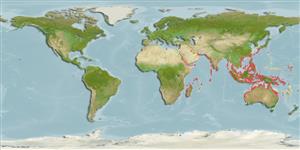>
Eupercaria/misc (Various families in series Eupercaria) >
Labridae (Wrasses) > Corinae
Etymology: Stethojulis: Greek, stetho, stethion = brest; literal = to prick a little breast + Greek, ioulis, a fish dealing with genera Coris or Thalassoma (Ref. 45335).
More on author: Bleeker.
Environment: milieu / climate zone / depth range / distribution range
Ökologie
seewasser riff-verbunden; tiefenbereich ? - 18 m (Ref. 90102). Tropical; 35°N - 33°S, 32°E - 168°E
Indo-West Pacific: Persian Gulf (Ref.80050); Red Sea and East Africa to Papua New Guinea, south to Lord Howe Island. Unknown from Micronesia.
Size / Gewicht / Alter
Maturity: Lm ? range ? - ? cm
Max length : 15.6 cm TL Männchen/unbestimmt; (Ref. 26587)
Rückenflossenstacheln (insgesamt): 9; Rückenflossenweichstrahlen (insgesamt): 11; Afterflossenstacheln 3; Afterflossenweichstrahlen: 11. True form has interrupted mid-lateral stripe. Female with yellow stripe from the tip of snout to just past axil, running below eye where pale silvery-blue; male with continuous mid-lateral line and dark 'ear' (Ref. 48636).
Coastal to outer reef crests. In Japan, it is found in areas of mixed sand, rock and coral (Ref. 9710). Occurs in small groups to about 20 m depth (Ref. 48636). Feeds by sorting small animals from mouthfuls of sand and detritus.
Life cycle and mating behavior
Geschlechtsreife | Fortpflanzung | Ablaichen | Eier | Fecundity | Larven
Oviparous, distinct pairing during breeding (Ref. 205).
Randall, J.E., 2000. Revision of the Indo-Pacific labrid fishes of the genus Stethojulis, with descriptions of two new species. Indo-Pac. Fish. (31):42 p. (Ref. 36378)
IUCN Rote Liste Status (Ref. 130435)
Bedrohung für Menschen
Harmless
Nutzung durch Menschen
Fischereien: nicht kommerziell; Aquarium: Kommerziell
Mehr Information
ReferenzenAquakulturAquakultur ProfilZuchtlinienGenetikElectrophoresesVererbbarkeitKrankheitenVerarbeitungNutrientsMass conversion
Tools
Zusatzinformationen
Download XML
Internet Quellen
Estimates based on models
Preferred temperature (Ref.
123201): 24.3 - 29.2, mean 28.4 °C (based on 2808 cells).
Phylogenetic diversity index (Ref.
82804): PD
50 = 0.5010 [Uniqueness, from 0.5 = low to 2.0 = high].
Bayesian length-weight: a=0.00977 (0.00548 - 0.01741), b=3.07 (2.92 - 3.22), in cm total length, based on LWR estimates for this species & Genus-body shape (Ref.
93245).
Trophic level (Ref.
69278): 3.4 ±0.3 se; based on diet studies.
Widerstandsfähigkeit (Ref.
120179): hoch, Verdopplung der Population dauert weniger als 15 Monate. (Preliminary K or Fecundity.).
Fishing Vulnerability (Ref.
59153): Low vulnerability (10 of 100).
Nutrients (Ref.
124155): Calcium = 101 [60, 174] mg/100g; Iron = 0.771 [0.443, 1.442] mg/100g; Protein = 18.5 [15.6, 20.7] %; Omega3 = 0.152 [0.096, 0.245] g/100g; Selenium = 20.8 [12.1, 38.4] μg/100g; VitaminA = 150 [46, 547] μg/100g; Zinc = 1.85 [1.26, 2.92] mg/100g (wet weight);
